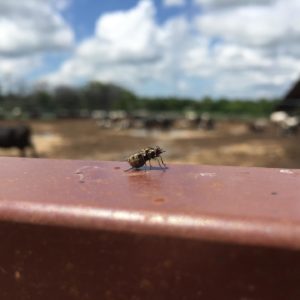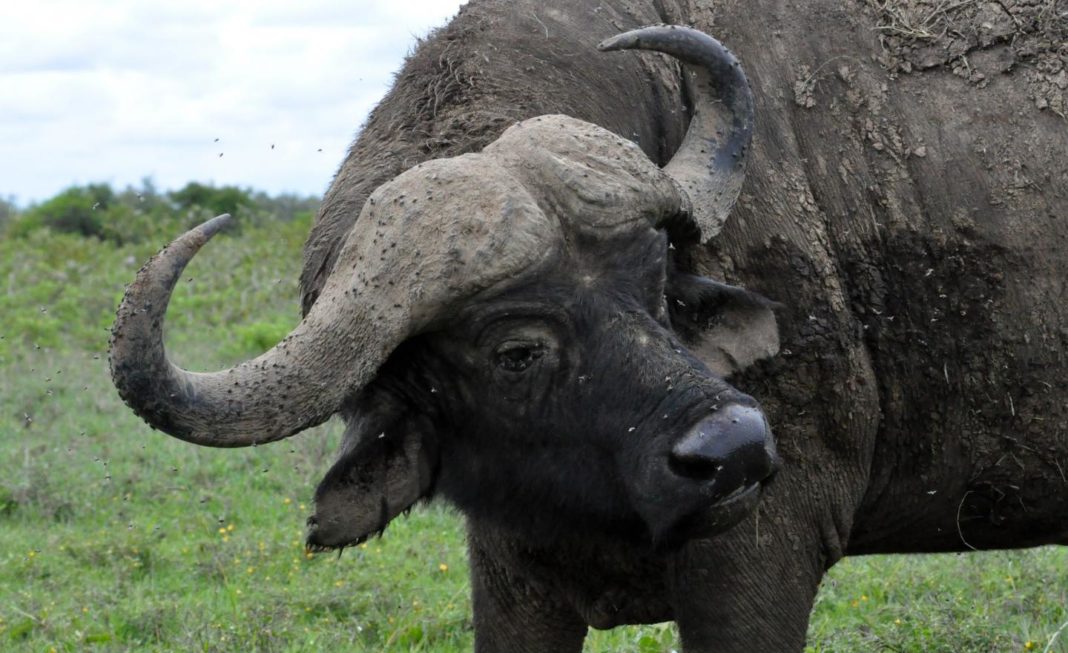Stable flies tormented Thomas Jefferson while he wrote the Declaration of Independence, history tells us. These bloodsucking pests are the scourge of beachgoers in Florida and recreational boaters in upstate New York.
Ubiquitously found around the world, stable flies cause an estimated $2.2 billion in damages in livestock production each year, according to the United States Department of Agriculture (USDA). Cows harassed by stable flies produce less milk and put on less weight.
Scientifically known as Stomoxys calcitrans, these spotted, tan-colored flies can easily be mistaken for the common housefly. But unlike their annoying but largely harmless cousins, they bite and feed on the blood of livestock and unlike mosquitoes, both male and female stable flies bite. Stable flies lay their eggs in wet, rotting vegetation like the wet hay or straw found around barns and stables that give them their name.

“If you get one in your house and it bites you, it’s a stable fly,” says Joshua Benoit, PhD, assistant professor of biology at the University of Cincinnati. “You shoo it away and shoo it away but it’s persistent and lands on you. And then it bites. And it’s not a pleasant bite. It’s a pretty vicious, painful bite.”
In a recent article published in the journal BMC Biology titled, “The genome of the stable fly, Stomoxys calcitrans, reveals potential mechanisms underlying reproduction, host interactions, and novel targets for pest control” a collaborative team of researchers unlocks the genome of stable flies as part of a research project called i5k that aims to sequence the genomes of 5,000 species of arthropods—the taxonomic group that includes spiders, insects and crabs.
“Stable flies are arguably one of the most important pests of livestock in the United States,” says Pia Untalan Olafson, PhD, U.S. Department of Agriculture, and the study’s lead author. The project bears significant economic effects ranging from tourism to agriculture in the US and beyond, says Olafson.
“It’s a pretty cool project. Molecular research on stable flies is far behind many other organisms. Our goal was to jump it up so we have a good model system to understand the biology of stable flies,” says Benoit, whose lab is part of the collaborative team of scientists. Researchers at the University of Cincinnati have sequenced bedbugs, thrips and screwworms in earlier studies.

Through sequencing the stable fly genome, the researchers were looking for possible genetic weaknesses to exploit in its genetic code, says Benoit. They examined stable fly biology using a combination of high-quality genome sequencing and RNA-Seq analyses at multiple developmental stages and tissues. They identified 1,600 genes related to stable fly reproduction, host-parasite interactions, and host-microbe dynamics which could lead to new biological control measures that would preclude the use of pesticides.
“Conducting research for its own sake is reward enough, but it is always heartening when the findings generate interesting novel avenues for exploration,” says Christopher Holmes, PhD, co-author on the study and a postdoctoral researcher at the University of Cincinnati.
“It’s a nonstop onslaught all the time. The flies need a blood meal to survive and reproduce. So they will keep trying to bite and trying to bite. They are very persistent,” says Benoit. “When you get a thousand of these biting a cow, it can have a huge impact on agricultural productivity.”
“Worldwide, these flies have become a societal issue of public and political importance,” says Olafson. “Growing international agroindustries, like pineapple, coffee and sugarcane, produce large amounts of byproduct that are ideal sites for stable fly larvae to develop. These sites can produce upwards of hundreds of thousands of flies per acre. Livestock producers and communities that neighbor these industries feel the impact.”
In addition to the economic significance, from a more basic evolutionary biology perspective, the study helps scientists better understand why some flies evolved to feed on blood while related species, like the fruit fly, did not.
By understanding the genes responsible for stable fly reproduction, researchers hope to design novel biological control strategies for this global pest. Similar methods have worked to eradicate other pests such as screwworms. For instance, the USDA raises screwworms by the millions, releasing sterilized males over Central America to keep them from pushing north to plague North American cattle ranches.
“Any targeted control like that is probably better than widescale pesticide application, which will kill all insects. So you don’t have to release chemicals into the environment,” says Benoit.



